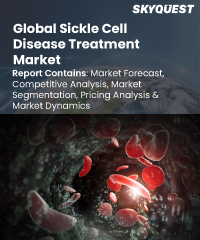
Product ID: SQMIG35D2091

Report ID:
SQMIG35D2091 |
Region:
Global |
Published Date: March, 2024
Pages:
219
|
Tables:
62 |
Figures:
75
Global Sickle Cell Disease Treatment Market size was valued at USD 2.10 billion in 2022 and is poised to grow from USD 2.55 billion in 2023 to USD 12.03 billion by 2031, growing at a CAGR of 21.4% during the forecast period (2024-2031).
Global Sickle Cell Disease Treatment Market is a dynamic and vital sector focused on addressing the medical needs of individuals suffering from sickle cell disease (SCD). SCD is a genetic blood disorder characterized by abnormal hemoglobin that causes red blood cells to become rigid and crescent-shaped, leading to various complications and health issues. The purpose of the market is to develop innovative therapies, medications, and supportive care options to improve the quality of life for individuals living with SCD. The high prevalence of sickle cell disease globally, particularly in sub-Saharan Africa, the Middle East, and certain regions of Asia, highlights the urgent need for effective treatments. Additionally, advancements in medical research, including gene therapy and targeted drug development, have opened new avenues for innovative treatment approaches. Furthermore, increasing awareness about SCD and its impact on patients' lives, coupled with government initiatives and support, have fueled investments in research and development. However, the market also faces certain restraints. Limited access to healthcare resources, especially in low-income regions, poses a challenge for effective diagnosis and treatment. Additionally, the high cost associated with advanced therapies and limited reimbursement options can impede market growth. Moreover, the complex nature of the disease and the need for personalized treatment approaches contribute to the challenges faced by healthcare providers and researchers.
Key trends in the market include the emergence of precision medicine and personalized treatment options tailored to individual patients' genetic profiles. Furthermore, collaborations between pharmaceutical companies, research institutions, and advocacy groups have gained prominence in the pursuit of innovative therapies. Opportunities in the market lie in expanding access to healthcare in underserved regions, developing cost-effective treatments, and exploring novel therapeutic modalities such as gene editing and stem cell transplantation. With increasing investments in research and development, advancements in technology, and a growing focus on improving patient outcomes, the global market presents an attractive opportunity for pharmaceutical companies, biotechnology firms, and healthcare providers to make a significant impact in addressing the unmet needs of individuals living with SCD. By harnessing the power of innovation, collaboration, and patient-centric approaches, the market holds the potential to transform the lives of millions affected by this challenging disease.
US Sickle Cell Disease Treatment Market is poised to grow at a sustainable CAGR for the next forecast year.
Our industry expert will work with you to provide you with customized data in a short amount of time.
REQUEST FREE CUSTOMIZATIONWant to customize this report? This report can be personalized according to your needs. Our analysts and industry experts will work directly with you to understand your requirements and provide you with customized data in a short amount of time. We offer $1000 worth of FREE customization at the time of purchase.

Product ID: SQMIG35D2091